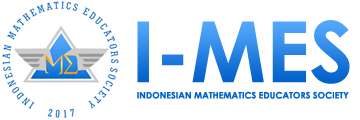Overcoming learning obstacles in cylinder and cone volume: A didactic design research approach
DOI:
https://doi.org/10.29408/jel.v11i4.31842Keywords:
cylinder and cone volume, didactic design, learning obstaclesAbstract
Many students encounter learning obstacles when understanding the volume of cylinders and cones; however, few studies have explicitly integrated these obstacles into didactic design. This study aimed to develop a didactic design to address specific learning obstacles in understanding the volume of cylinders and cones. Using a Didactic Design Research (DDR) approach grounded in Brousseau’s Theory of Didactic Situations, the study involved 28 seventh-grade students and a mathematics teacher from a junior high school in Pontianak, selected through purposive sampling. Data were collected through observations, diagnostic tests, and interviews and then analyzed qualitatively using interpretative and critical techniques. The didactic design consisted of four didactic situations: action, formulation, validation, and institutionalization, implemented in classroom practice. The institutional phase revealed several limitations, particularly a lack of sufficient scaffolding and inadequate visual support for students’ spatial reasoning. The findings indicate that addressing epistemological obstacles, such as misconceptions regarding the interpretation of height and base area in three-dimensional solids, can enhance students’ conceptual understanding. The study suggests that integrating learning obstacle analysis into didactic design helps refine future implementations to better anticipate students’ cognitive development.
References
Abouelenein, Y. A. M., & Elmaadaway, M. A. N. (2023). Impact of teaching a neuro computerized course through VLE to develop computational thinking among mathematics pre-service teachers. Journal of Educational Computing Research, 61(6), 1175–1206.
Agustini, W. A., & Fitriani, N. (2021). Analisis kesulitan siswa SMP pada materi bangun ruang sisi lengkung [Analysis of junior high school students’ difficulties in curved surface solids. Jurnal Pembelajaran Matematika Inovatif, 4(1), 91–96.
Aisyah, A. P., Prabandari, A. R., Natalia, E., Rahmadhani, N., Susanti, E., Meryansumayeka, M., Zulkardi, Z., & Yukans, S. S. (2024). Pengembangan alat peraga Prolucc pada materi volume tabung dan kerucut [Development of Prolucc teaching aids on the topic of cylinder and cone volume. Jurnal Borobudur Educational Review, 4(1), 50–60.
Alfansyur, A., & Mariyani, M. (2020). Seni mengelola data: Penerapan triangulasi teknik, sumber dan waktu pada penelitian pendidikan sosial [The art of managing data: Application of technique, source, and time triangulation in social education research. Jurnal Kajian, Penelitian & Pengembangan, 5(2), 146–150.
Andani, M., Jamilah, J., & Hartono, H. (2021). Didactical obstacle siswa kelas IX pada materi deret geometri [Didactical obstacles of ninth-grade students on geometric sequences. Journal of Innovation Research and Knowledge, 1(5), 887–894.
Battista, M. T. (2007). The development of geometric and spatial thinking. In F. K. Lester, Jr. (Ed.), Second handbook of research on mathematics teaching and learning (pp. 843–908). Information Age Publishing.
Boaler, J. (2016). Mathematical mindsets: Unleashing students’ potential through creative math, inspiring messages and innovative teaching.
Brousseau, G. (1997). Theory of didactical situations in mathematics: Didactique des mathématiques, 1970–1990. Kluwer Academic Publishers.
Chevallard, Y. (1985). La transposition didactique: Du savoir savant au savoir enseigné. La Pensée Sauvage.
Even, R., & Ball, D. L. (2009). The professional education and development of teachers of mathematics: The 15th ICMI study. Springer.
Fischbein, E. (1987). Intuition in science and mathematics: An educational approach. D. Reidel Publishing Company.
Gravemeijer, K., & Cobb, P. (2006). Design research from a learning design perspective. In J. Akker, K. Gravemeijer, S. McKenney, & N. Nieveen (Eds.), Educational design research (pp. 17–51). Routledge.
Habibah, U., Santika, R., Setiono, P., Yuliantini, N., & Wurdjinem, W. (2021). Analisis kesulitan belajar siswa SD dalam pembelajaran matematika secara daring [Analysis of elementary students’ learning difficulties in online mathematics learning. Jurnal Ilmiah Matematika Realistik, 2(2), 1–6.
Jamilah, J. (2021). Proses transposisi didaktik mahasiswa calon guru matematika melalui didactical design research pada materi himpunan [Didactical transposition process of preservice mathematics teachers through didactical design research on set theory [Ph.D. Thesis, Universitas Pendidikan Indonesia].
Jamilah, J., Priskila, P., & Oktaviana, D. (2024). Didactical design to overcome learning obstacles in cuboid volume. Jurnal Elemen, 10(2), 324–340.
Jamilah, J., & Winarji, A. (2021). Pengorganisasian situasi didaktis dalam pembelajaran panjang busur lingkaran [Organization of didactical situations in teaching arc length. In Konferensi Penelitian Desain Didaktik.
Kamaria, A. (2021). Implementasi kebijakan penataan dan mutasi guru pegawai negeri sipil di lingkungan dinas pendidikan Kabupaten Halmahera Utara [Implementation of civil servant teacher transfer and placement policies in the Department of Education of North Halmahera. Jurnal Ilmiah Wahana Pendidikan, 7(3), 82–96.
Mahmud, M. R., Turmudi, T., Sopandi, W., Rohimah, S. M., & Pratiwi, I. M. (2023). Analisis hambatan belajar kelipatan persekutuan terkecil dan faktor persekutuan terbesar di sekolah dasar [Analysis of learning obstacles on LCM and GCF topics in elementary school. Jurnal Elemen, 9(2), 440–449. https://doi.org/10.29408/jel.v9i2.12359
Nurfajriani, W. V., Ilhami, M. W., Mahendra, A., Sirodj, R. A., & Afgani, M. W. (2024). Triangulasi data dalam analisis data kualitatif [Data triangulation in qualitative data analysis. Jurnal Ilmiah Wahana Pendidikan, 10(17), 826–833.
Pebriyanti, G. W., Sari, D., & Hadi, M. (2017). Profil hambatan belajar epistemologis siswa pada materi asas Bernoulli kelas XI SMA berbasis analisis tes kemampuan responden [Profile of students. 6, 1–8.
Pramuditya, S. A., Noto, M. S., & Handayani, V. D. (2021). Desain didaktis konteks fabel berbasis pemahaman matematis siswa pada materi aljabar [Didactical design using fable contexts based on students’ mathematical understanding of algebra. Jurnal Elemen, 7(1), 68–83.
Prediger, S., Bikner-Ahsbahs, A., & Arzarello, F. (2015). Networking theories in mathematics education. In S. Prediger (Ed.), ICME-13 topical survey: Networking of theories as a research practice in mathematics education. Springer.
Prévost, P., Mary, C., & Martin, R. (2022). Applying Didactical Design Research to foster algebraic reasoning: An international classroom-based study. International Journal of Science and Mathematics Education, 20(3), 551–573.
Priskila, P., Jamilah, J., & Oktaviana, D. (2023). Analisis learning obstacle siswa SMP pada materi volume kubus dan balok [Analysis of junior high school students’ learning obstacles on cube and cuboid volume. Journal of Comprehensive Science, 2(6), 1656–1663.
Purnama, S. D., Fadillah, S., & Jamilah, J. (2023). Analisis hambatan belajar siswa pada materi pembelajaran himpunan siswa kelas 7 SMP Negeri 4 Sungai Ambawang [Analysis of students’ learning obstacles on set learning material among seventh graders of SMP Negeri 4 Sungai Ambawang. Juwara: Jurnal Wawasan dan Aksara, 3(1), 43–56. https://doi.org/10.58740/juwara.v3i1.46
Putra, R. W. Y., & Setiawati, N. (2018). Pengembangan desain didaktis bahan ajar persamaan garis lurus [Development of didactical design for straight-line equation teaching materials. Jurnal Penelitian dan Pembelajaran Matematika, 11(1), 139–148.
Rahmawati, E., Pranata, O. H., & Lidinillah, D. A. M. (2021). Desain didaktis materi volume kubus dan balok berbasis teori Van Hiele untuk mengatasi learning obstacle siswa. 8, 780–791.
Ramli, R., & Sufyani, P. (2020). Kesalahan dan learning obstacle dalam menyelesaikan permasalahan matematis [Errors and learning obstacles in solving mathematical problems. Juring: Journal for Research in Mathematics Learning, 3(3), 233–246.
Sari, W., Fauziah, F., & Jayanti, J. (2019). Analisis kendala pembelajaran materi segitiga pada siswa SMP kelas 7 [Analysis of learning difficulties on triangle material among seventh-grade students. Jurnal Inovasi Pendidikan Matematika, 2(1), 21–29. https://doi.org/10.31851/indiktika.v2i1.3394
Shabrina, F. A., Sumiaty, E., & Sudihartinih, E. (2022). Kajian learning obstacle pada materi peluang untuk jenjang SMP ditinjau dari literasi matematis PISA 2021 [Study of learning obstacles in probability material for junior high school based on PISA 2021 mathematical literacy. Jurnal Pendidikan Matematika: Judika Education, 5(2), 152–165.
Sidik, G. S., Suryadi, D., & Turmudi, T. (2021). Learning obstacle on addition and subtraction of primary school students: Analysis of algebraic thinking. Education Research International, Article, ID, 5935179.
Simon, M. A. (1995). Reconstructing mathematics pedagogy from a constructivist perspective. Journal for Research in Mathematics Education, 26(2), 114–145.
Sitanggang, A. K., Lubis, A., & Elisa, T. S. (2024). Pengembangan model Design Didactic Research (DDR) untuk mengatasi hambatan belajar (learning obstacle) matematika [Development of the Didactical Design Research (DDR) model to overcome mathematics learning obstacles. Jurnal Handayani, 15(1), 1–6.
Solin, T. A., Fitria, N., Sitorus, S. F., & Angkat, D. K. A. (2023). Analisis kesulitan siswa dalam menyelesaikan soal bangun ruang sisi lengkung [Analysis of students’ difficulties in solving curved surface solid problems. Relevan: Jurnal Pendidikan, 3(4), 458–465.
Sulastri, R., Suryadi, D., Prabawanto, S., & Cahya, E. (2022). Epistemological obstacles on limit and functions concepts: A phenomenological study in online learning. MATHEMATICS TEACHING RESEARCH JOURNAL, 14(4), 84–106.
Suryadi, D. (2019). Landasan filosofis penelitian desain didaktis (DDR) [Philosophical foundations of didactical design research. DDR)]. Pusat Pengembangan DDR Indonesia.
Suryadi, D., & Prabawanto, S. (2020). Metapedadidaktik dalam penelitian desain didaktis [Metapedadidactics in didactical design research. Jurnal Didaktik Matematika, 7(1), 1–12.
Suryani, T., Jamilah, J., & Astuti, R. (2025). Analisis learning obstacle konsep volume tabung dan kerucut siswa kelas VIII [Analysis of learning obstacles on the concept of cylinder and cone volume among eighth-grade students. JRPMS: Jurnal Riset Pembelajaran Matematika Sekolah, 9(1), 75–85.
Triyono, T., Masrukan, M., & Mulyono, M. (2023). Pengembangan tes diagnostik matematika kurikulum Merdeka [Development of a diagnostic mathematics test for the Merdeka curriculum. Jurnal Prisma, 12(2), 560–569.
Turner, D. P. (2020). Sampling methods in research design. Headache: The Journal of Head & Face Pain, 60(1), 8–12.
Wahyono, I. (2018). Implementasi nilai-nilai Pancasila dalam kegiatan pembelajaran di SDN 1 Sekarsuli [Implementation of Pancasila values in learning activities at SDN 1 Sekarsuli. Jurnal Pendidikan Guru Sekolah Dasar, 7(2), 133–139.
Widodo, S. A., Wijayanti, A., Irfan, M., Pusporini, W., Mariah, S., & Rochmiyati, S. (2023). Effects of worksheets on problem-solving skills: Meta-analytic studies. International Journal of Educational Methodology, 9(1), 151–167.
Yunarti, T. (2017). Desain didaktis berbasis masalah untuk teori peluang SMA [Problem-based didactical design for probability theory in senior high school. Media Akademi.
Downloads
Published
How to Cite
Issue
Section
License
Copyright (c) 2025 Titin Suryani, Jamilah, Reni Astuti

This work is licensed under a Creative Commons Attribution-ShareAlike 4.0 International License.
Authors who publish with the Jurnal Elemen agree to the following terms:
- Authors retain copyright and grant the journal right of first publication with the work simultaneously licensed under Creative Commons Attribution-ShareAlike 4.0 International License (CC BY-SA 4.0).
- Authors are able to enter into separate, additional contractual arrangements for the distribution of the journal's published version of the work (e.g., post it to an institutional repository or publish it in a book), with an acknowledgment of its initial publication in this journal.
- Authors are permitted and encouraged to post their work online (e.g., in institutional repositories or on their website) prior to and during the submission process, as it can lead to productive exchanges, as well as earlier and greater citation of published work.
Jurnal Elemen is licensed under a Creative Commons Attribution-ShareAlike 4.0 International License





